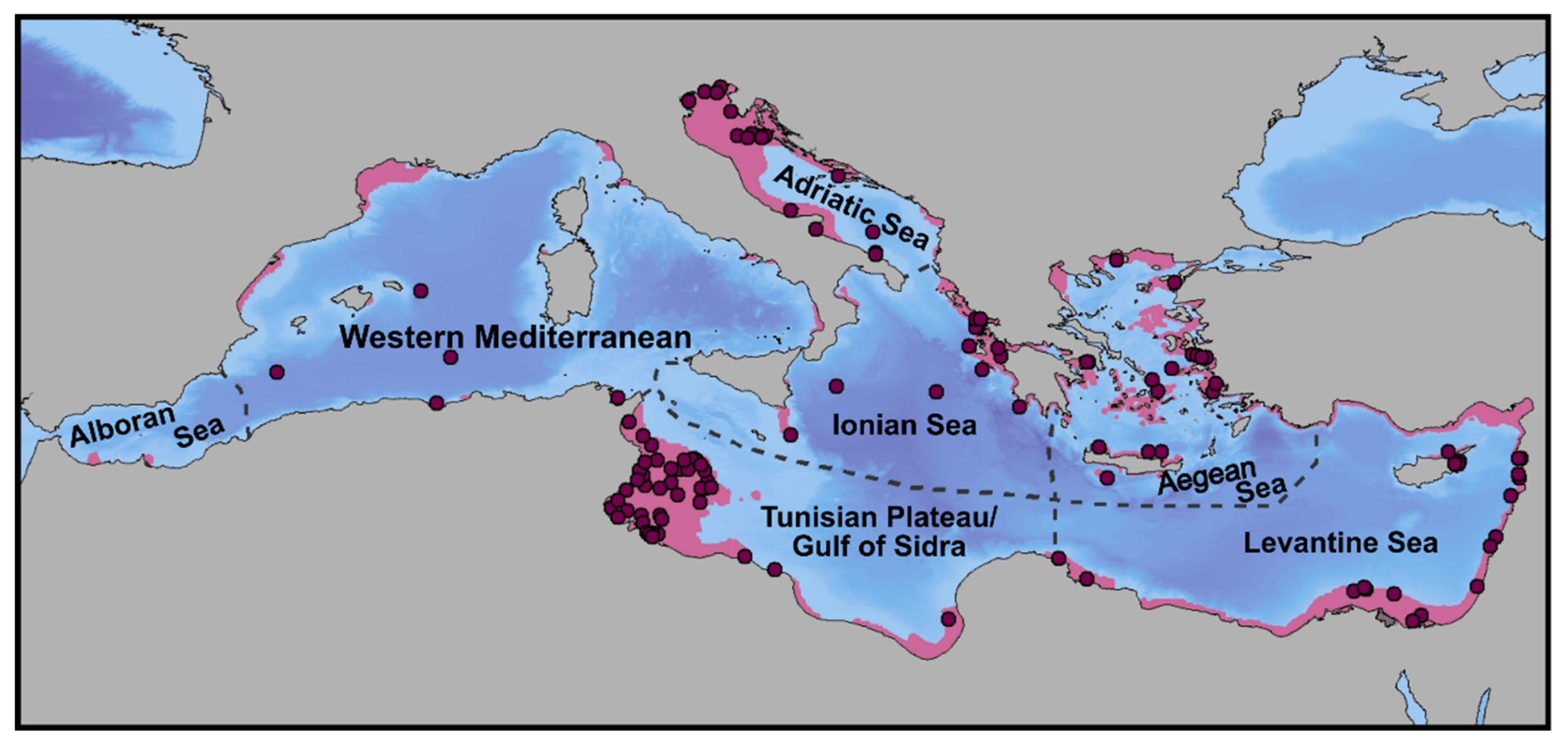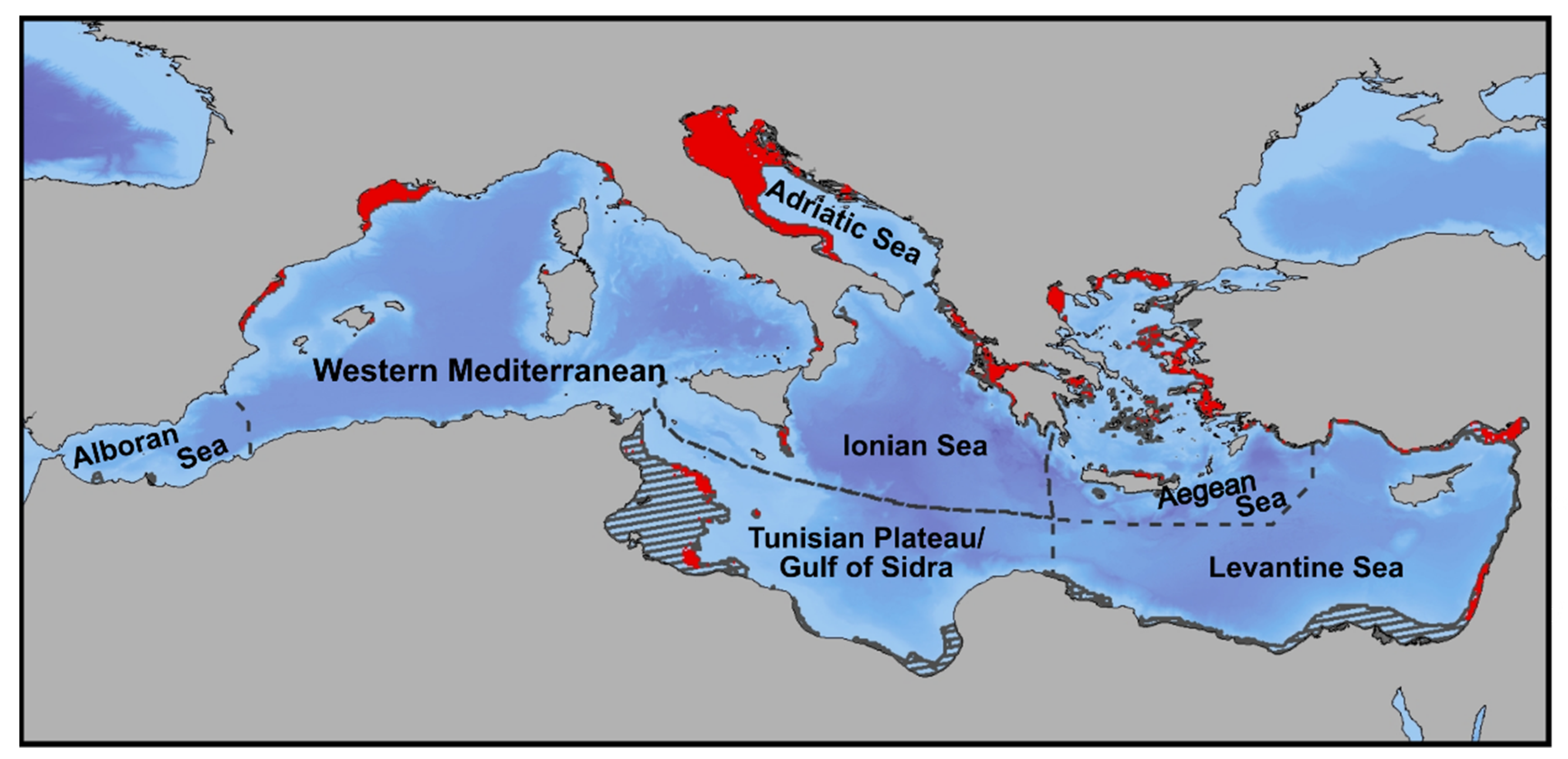Investigating the Distribution of Foraging Habitat for Loggerhead Sea Turtles, Caretta caretta, in the Mediterranean Sea †
Abstract
:1. Introduction
2. Methods
3. Results
4. Discussion
5. Conclusions
Author Contributions
Funding
Institutional Review Board Statement
Informed Consent Statement
Data Availability Statement
Conflicts of Interest
References
- Estes, J.A.; Heithaus, M.; McCauley, D.J.; Rasher, D.B.; Worm, B. Megafaunal impacts on structure and function of ocean ecosystems. Annu. Rev. Environ. Resour. 2016, 41, 83–116. [Google Scholar] [CrossRef] [Green Version]
- Pimiento, C.; Leprieur, F.; Silvestro, D.; Lefcheck, J.; Albouy, C.; Rasher, D.; Davis, M.; Svenning, J.-C.; Griffin, J. Functional diversity of marine megafauna in the Anthropocene. Sci. Adv. 2020, 6, eaay7650. [Google Scholar] [CrossRef] [Green Version]
- Hays, G.C.; Ferreira, L.C.; Sequeira, A.M.; Meekan, M.G.; Duarte, C.M.; Bailey, H.; Bailleul, F.; Bowen, W.D.; Caley, M.J.; Costa, D.P.; et al. Key questions in marine megafauna movement ecology. Trends Ecol. Evol. 2016, 31, 463–475. [Google Scholar] [CrossRef] [Green Version]
- Hays, G.C.; Scott, R. Global patterns for upper ceilings on migration distance in sea turtles and comparisons with fish, birds and mammals. Funct. Ecol. 2013, 27, 748–756. [Google Scholar] [CrossRef]
- Rees, A.F.; Margaritoulis, D.; Newman, R.; Riggall, T.E.; Tsaros, P.; Zbinden, J.A.; Godley, B.J. Ecology of loggerhead marine turtles Caretta caretta in a neritic foraging habitat: Movements, sex ratios and growth rates. Mar. Biol. 2013, 160, 519–529. [Google Scholar] [CrossRef]
- Rees, A.F.; Alfaro-Shigueto, J.; Barata, P.; Bjorndal, K.A.; Bolten, A.B.; Bourjea, J.; Broderick, A.; Campbell, L.; Cardona, L.; Carreras, C.; et al. Are we working towards global research priorities for management and conservation of sea turtles? Endanger. Species Res. 2016, 31, 337–382. [Google Scholar] [CrossRef] [Green Version]
- Wallace, B.P.; DiMatteo, A.D.; Bolten, A.B.; Chaloupka, M.Y.; Hutchinson, B.J.; Abreu-Grobois, F.A.; Mortimer, J.A.; Seminoff, J.A.; Amorocho, D.; Bjorndal, K.A.; et al. Global conservation priorities for marine turtles. PLoS ONE 2011, 6, e24510. [Google Scholar] [CrossRef]
- Luschi, P.; Mencacci, R.; Cerritelli, G.; Papetti, L.; Hochscheid, S. Large-scale movements in the oceanic environment identify important foraging areas for loggerheads in central Mediterranean Sea. Mar. Biol. 2018, 165, 4. [Google Scholar] [CrossRef]
- Casale, P.; Broderick, A.C.; Camiñas, J.A.; Cardona, L.; Carreras, C.; Demetropoulos, A.; Fuller, W.J.; Godley, B.J.; Hochscheid, S.; Kaska, Y.; et al. Mediterranean sea turtles: Current knowledge and priorities for conservation and research. Endanger. Species Res. 2018, 36, 229–267. [Google Scholar] [CrossRef] [Green Version]
- Mazor, T.; Beger, M.; McGowan, J.; Possingham, H.P.; Kark, S. The value of migration information for conservation prioritization of sea turtles in the Mediterranean. Glob. Ecol. Biogeogr. 2016, 25, 540–552. [Google Scholar] [CrossRef]
- Hays, G.C.; Hawkes, L.A. Satellite tracking sea turtles: Opportunities and challenges to address key questions. Front. Mar. Sci. 2018, 5, 432. [Google Scholar] [CrossRef]
- Casale, P. Sea turtle by-catch in the Mediterranean. Fish Fish. 2011, 12, 299–316. [Google Scholar] [CrossRef]
- Spalding, M.D.; Fox, H.E.; Allen, G.R.; Davidson, N.; Ferdaña, Z.A.; Finlayson, M.; Halpern, B.S.; Jorge, M.A.; Lombana, A.; Lourie, S.A.; et al. Marine ecoregions of the world: A bioregionalization of coastal and shelf areas. BioScience 2007, 57, 573–583. [Google Scholar] [CrossRef] [Green Version]
- Cavicchia, L.; Gualdi, S.; Sanna, A.; Oddo, P. The Regional Ocean-Atmosphere Coupled Model COSMO-NEMO_MFS. In CMCC Research Paper; The Euro-Mediteranean Centre on Climate Change: Lecce, Italy, 2015; Volume RP0254, pp. 1–22. [Google Scholar]
- Hijmans, R.J.; Cameron, S.E.; Parra, J.L.; Jones, P.G.; Jarvis, A. Very high resolution interpolated climate surfaces for global land areas. Int. J. Clim. 2005, 25, 1965–1978. [Google Scholar] [CrossRef]
- Araújo, M.B.; New, M. Ensemble forecasting of species distributions. Trends Ecol. Evol. 2007, 22, 42–47. [Google Scholar] [CrossRef]
- Naimi, B.; Araújo, M.B. sdm: A reproducible and extensible R platform for species distribution modelling. Ecography 2016, 39, 368–375. [Google Scholar] [CrossRef] [Green Version]
- Fielding, A.H.; Bell, J.F. A review of methods for the assessment of prediction errors in conservation presence/absence models. Environ. Conserv. 1997, 24, 38–49. [Google Scholar] [CrossRef]
- Allouche, O.; Tsoar, A.; Kadmon, R. Assessing the accuracy of species distribution models: Prevalence, kappa and the true skill statistic (TSS). J. Appl. Ecol. 2006, 43, 1223–1232. [Google Scholar] [CrossRef]
- Liu, C.; White, M.; Newell, G. Selecting thresholds for the prediction of species occurrence with presence-only data. J. Biogeogr. 2013, 40, 778–789. [Google Scholar] [CrossRef]
- Luschi, P.; Casale, P. Movement patterns of marine turtles in the Mediterranean Sea: A review. Ital. J. Zool. 2014, 81, 478–495. [Google Scholar] [CrossRef] [Green Version]
- GEBCO—General Bathymetric Chart of the Oceans. Gridded Bathymetry Data. Available online: https://download.gebco.net/ (accessed on 15 December 2020).
- Global Fishing Watch. Available online: http://globalfishingwatch.org/ (accessed on 20 December 2020).
- Kroodsma, D.A.; Mayorga, J.; Hochberg, T.; Miller, N.A.; Boerder, K.; Ferretti, F.; Wilson, A.; Bergman, B.; White, T.D.; Block, B.A.; et al. Tracking the global footprint of fisheries. Science 2018, 359, 904–908. [Google Scholar] [CrossRef] [Green Version]
- Sequeira, A.M.M.; Hays, G.C.; Sims, D.W.; Eguíluz, V.M.; Rodríguez, J.P.; Heupel, M.R.; Harcourt, R.; Calich, H.; Queiroz, N.; Costa, D.P. Overhauling ocean spatial planning to improve marine megafauna conservation. Front. Mar. Sci. 2019, 6, 639. [Google Scholar] [CrossRef]
- Haywood, J.C.; Fuller, W.J.; Godley, B.J.; Margaritoulis, D.; Shutler, J.D.; Snape, R.T.; Widdicombe, S.; Zbinden, J.A.; Broderick, A.C. Spatial ecology of loggerhead turtles: Insights from stable isotope markers and satellite telemetry. Divers. Distrib. 2020, 26, 368–381. [Google Scholar] [CrossRef]
- Schofield, G.; Dimadi, A.; Fossette, S.; Katselidis, K.A.; Koutsoubas, D.; Lilley, M.K.; Luckman, A.; Pantis, J.D.; Karagouni, A.D.; Hays, G.C. Satellite tracking large numbers of individuals to infer population level dispersal and core areas for the protection of an endangered species. Divers. Distrib. 2013, 19, 834–844. [Google Scholar] [CrossRef]
- Darmon, G.; Miaud, C.; Claro, F.; Doremus, G.; Galgani, F. Risk assessment reveals high exposure of sea turtles to marine debris in French Mediterranean and metropolitan Atlantic waters. Deep Sea Res. 2017, 141, 319–328. [Google Scholar] [CrossRef] [Green Version]
- Tomás, J.; Gozalbes, P.; Raga, J.A.; Godley, B.J. Bycatch of loggerhead sea turtles: Insights from 14 years of stranding data. Endanger. Species Res. 2008, 5, 161–169. [Google Scholar] [CrossRef]
- Lucchetti, A.; Vasapollo, C.; Virgili, M. An interview-based approach to assess sea turtle bycatch in Italian waters. PeerJ 2017, 5, e3151. [Google Scholar] [CrossRef] [Green Version]
- Báez, J.C.; García-Barcelona, S.; Camiñas, J.A.; Macías, D. Fishery strategy affects the loggerhead sea turtle mortality trend due to the longline bycatch. Fish. Res. 2019, 212, 21–28. [Google Scholar] [CrossRef]
- Panagopoulou, A.; Meletis, Z.A.; Margaritoulis, D.; Spotila, J.R. Caught in the same net? small-scale fishermen’s perceptions of fisheries interactions with sea turtles and other protected species. Front. Mar. Sci. 2017, 4, 180. [Google Scholar] [CrossRef] [Green Version]
- Esenlioğulları Mete, A.; Tosunoğlu, Z. Interactions between sea turtles and fishing along the Aegean Coast of Turkey. Aquat. Sci. Eng. 2019, 34, 7–13. [Google Scholar] [CrossRef]
- Lewison, R.L.; Crowder, L.B.; Wallace, B.P.; Moore, J.E.; Cox, T.; Zydelis, R.; McDonald, S.; DiMatteo, A.; Dunn, D.C.; Kot, C.Y.; et al. Global patterns of marine mammal, seabird, and sea turtle bycatch reveal taxa-specific and cumulative megafauna hotspots. Proc. Natl. Acad. Sci. USA 2014, 111, 5271–5276. [Google Scholar] [CrossRef] [Green Version]
- López-Mendilaharsu, M.; Giffoni, B.; Monteiro, D.; Prosdocimi, L.; Vélez-Rubio, G.M.; Fallabrino, A.; Estrades, A.; dos Santos, A.S.; Lara, P.H.; Pires, T.; et al. Multiple-threats analysis for loggerhead sea turtles in the southwest Atlantic Ocean. Endanger. Species Res. 2020, 41, 183–196. [Google Scholar] [CrossRef] [Green Version]
- Williams, J.L.; Pierce, S.J.; Hamann, M.; Fuentes, M.M. Using expert opinion to identify and determine the relative impact of threats to sea turtles in Mozambique. Aquat. Conserv. 2019, 29, 1936–1948. [Google Scholar] [CrossRef]
- Varo-Cruz, N.; Bermejo, J.A.; Calabuig, P.; Cejudo, D.; Godley, B.J.; López-Jurado, L.F.; Pikesley, S.K.; Witt, M.J.; Hawkes, L.A. New findings about the spatial and temporal use of the Eastern Atlantic Ocean by large juvenile loggerhead turtles. Divers. Distrib. 2016, 22, 481–492. [Google Scholar] [CrossRef]
- Pikesley, S.K.; Broderick, A.C.; Cejudo, D.; Coyne, M.S.; Godfrey, M.H.; Godley, B.J.; Lopez, P.; López-Jurado, L.F.; Elsy Merino, S.; Varo-Cruz, N. Modelling the niche for a marine vertebrate: A case study incorporating behavioural plasticity, proximate threats and climate change. Ecography 2015, 38, 803–812. [Google Scholar] [CrossRef]
- Schofield, G.; Hobson, V.J.; Fossette, S.; Lilley, M.K.; Katselidis, K.A.; Hays, G.C. Fidelity to foraging sites, consistency of migration routes and habitat modulation of home range by sea turtles. Divers. Distrib. 2010, 16, 840–853. [Google Scholar] [CrossRef]


Publisher’s Note: MDPI stays neutral with regard to jurisdictional claims in published maps and institutional affiliations. |
© 2021 by the authors. Licensee MDPI, Basel, Switzerland. This article is an open access article distributed under the terms and conditions of the Creative Commons Attribution (CC BY) license (https://creativecommons.org/licenses/by/4.0/).
Share and Cite
Almpanidou, V.; Chatzimentor, A.; Tsapalou, V.; Mazaris, A.D. Investigating the Distribution of Foraging Habitat for Loggerhead Sea Turtles, Caretta caretta, in the Mediterranean Sea. Biol. Life Sci. Forum 2021, 2, 27. https://doi.org/10.3390/BDEE2021-09423
Almpanidou V, Chatzimentor A, Tsapalou V, Mazaris AD. Investigating the Distribution of Foraging Habitat for Loggerhead Sea Turtles, Caretta caretta, in the Mediterranean Sea. Biology and Life Sciences Forum. 2021; 2(1):27. https://doi.org/10.3390/BDEE2021-09423
Chicago/Turabian StyleAlmpanidou, Vasiliki, Anastasia Chatzimentor, Vasiliki Tsapalou, and Antonios D. Mazaris. 2021. "Investigating the Distribution of Foraging Habitat for Loggerhead Sea Turtles, Caretta caretta, in the Mediterranean Sea" Biology and Life Sciences Forum 2, no. 1: 27. https://doi.org/10.3390/BDEE2021-09423




